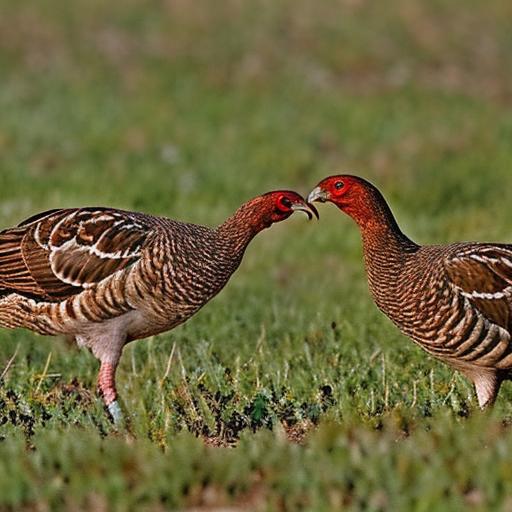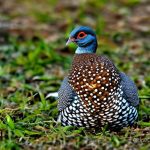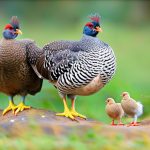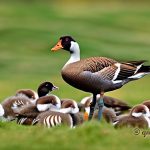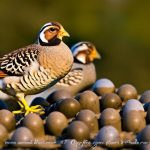Are you captivated by the spirited display of turkeys during their mating season? Maybe you’ve caught a glimpse of these feathered performers in the wild, strutting with pride and filling the air with their robust gobbles.
You’re certainly not alone in your wonderment! Like many nature enthusiasts, I too have spent countless hours spellbound by their rituals and yearned to uncover the secrets behind such flamboyant displays.
After poring over studies and observing these magnificent birds in person, I’m thrilled to bring some insight into the world of turkey courtship. It turns out that turkeys enter into a specific season for romance, typically from February through early June all across our nation.
This pivotal period influences not just hunting calendars but also enriches bird watching experiences for avid fans like ourselves. My article unpacks everything from key dates to captivating phases and behaviors of turkey mating season in an accessible way that’s sure to entertain as much as it informs.
So fluff up those metaphorical feathers—by the time we’re done exploring this topic, we’ll strut through our newfound knowledge together with just as much confidence as those showy turkeys!
Understanding Turkey Mating Seasons
Different species and regions will have varying breeding times influenced by factors such as climate and food availability. Understanding the specific mating season for turkeys is essential for any turkey keeper or wildlife enthusiast.
Different species and regions
Wild turkeys spread out across the United States have their special times for breeding. In the North, cold snaps might push these dates later, sometimes starting as late into April or May.
Down South, where flowers bloom early and it’s warmer, turkeys might start looking for mates as soon as February. Each region follows its own calendar, but generally, you’ll find that by early June, most of the action has quieted down.
Eastern wild turkeys in wooded areas behave differently than Rio Grande turkeys living near rivers out West. Climate and habitat shape their cycles quite a bit. For us turkey keepers tuned into nature’s cues like day length and temperatures, we can almost tell when our feathered friends will begin their dance of courtship.
Factors that influence breeding time
Factors that influence breeding time:
- Day Length: Increasing daylight hours in spring trigger hormonal changes in turkeys, prompting breeding behavior.
- Weather Conditions: Mild weather and sufficient food supply influence the timing of turkey mating seasons.
- Habitat Quality: Availability of suitable nesting sites and food sources can impact when turkeys breed.
- Population Density: Higher turkey populations may lead to earlier initiation of breeding activities due to competitive pressures for mates and resources.
- Predation Risk: Turkeys may delay or advance breeding based on perceived risk from predators during nesting and rearing of young.
The Lifecycle of a Wild Turkey
Winter flocks and migration lead to the spring nesting season, where turkeys begin breeding. The first days of a turkey’s life are crucial for their survival in the wild.
Winter flocks and migration
During winter, turkeys form flocks for safety and warmth. They often gather in wooded areas where food is available. When spring arrives, these flocks start to break up as the mating season begins.
Turkeys may migrate to different areas to find suitable nesting sites, leading to changes in their behavior during this period.
As temperatures rise, turkeys leave winter flocks and begin establishing breeding territories. This transition marks the start of courtship rituals and the search for potential mates among hens.
Spring nesting season
Spring nesting season sees the wild turkey hens preparing their nests. They select a site on the ground, often at the base of a tree or brush pile, concealed by tall grasses and shrubs.
The hen will lay one egg per day until she has a complete clutch before starting to incubate them. This process typically takes about 14-28 days, depending on how many eggs the hen lays.
Male turkeys are not involved in nest building or incubation but play an important role in protecting the nesting area. Predators like raccoons and snakes are always on the lookout for unguarded nests, so it’s crucial for keepers to ensure that potential threats are minimized during this time.
The first days of a turkey
After the spring nesting season, turkeys begin their journey into parenthood. During these first days after nesting, female turkeys attentively guard and incubate their eggs as they eagerly anticipate the arrival of their young poults.
Once hatched, the mother turkey diligently leads her brood to find food and shelter while protecting them from predators.
As a turkey keeper, it’s crucial to understand that within 24 hours of hatching, poults are mobile and ready to follow their mother. The newborns depend on insects for their primary source of protein during this stage.
Providing a habitat with plentiful cover and insect populations will support the survival of poults through these delicate early days.
Turkey Breeding Season Phases
During the breeding season, turkeys go through three distinct phases: harem gathering, breeding flocks, and deserted gobblers. Each phase has its own unique behaviors and interactions that play a crucial role in the mating process.
Understanding these phases is essential for anyone interested in turkey behavior or spring hunting opportunities.
Harem gathering
During harem gathering, male turkeys begin to court multiple female turkeys, creating a group of females known as a harem. The dominant tom uses various displays and calls to attract the hens into his group.
This phase is critical for establishing dominance and determining which toms will have access to breeding opportunities. As turkey keepers, understanding this behavior can help us monitor the interactions in our flocks and prepare for potential changes in social dynamics during the mating season.
—
Breeding flocks
Breeding flocks are an important phase during the turkey mating season. Male turkeys, also known as “toms,” gather together groups of hens into a small area, creating what is called a breeding flock.
This behavior is their way of attracting and keeping the attention of female turkeys for mating. During this time, toms display their brightly colored feathers and engage in competitive behaviors to impress the hens.
Within these breeding flocks, competition among male turkeys intensifies as they vie for the opportunity to mate with the available females. Toms showcase their colorful plumage and strut around, emitting distinctive gobbling sounds to assert dominance and attract mates.
Deserted gobblers
Transitioning from the dynamics of breeding flocks, it’s crucial to understand the phase that follows, known as deserted gobblers. During this phase, male turkeys who have not been successful in establishing a harem or breeding flock may become solitary and display less active mating behaviors.
It’s important to note that these deserted gobblers could still be present in the hunting areas even after the peak breeding season has passed.
Despite the decreased activity in males’ courtship behaviors during this phase, turkey keepers should remain vigilant. It’s essential to recognize that while some male turkeys may seem uninterested or inactive, they are still part of the overall mating dynamic in a given area.
Behavior During Mating Season
During mating season, turkeys exhibit social interactions, courtship rituals, and nesting behaviors that are fascinating to observe. Read on to learn more about the intricate behaviors of wild turkeys during their breeding season.
Social interactions
During the mating season, wild turkeys are very social animals. They gather in large flocks and exhibit a range of behaviors to attract mates. Male turkeys often engage in elaborate courtship displays, including puffing up their feathers, strutting, and making distinctive calls to gain the attention of female turkeys.
These social interactions are crucial for successful breeding as they allow individuals to establish dominance and form mating pairs. Understanding these behaviors can offer turkey keepers valuable insights into the reproductive cycle and help them create suitable conditions for their turkeys.
– Courtship rituals
Courtship rituals
As turkey keepers, it’s crucial to understand the courtship rituals of these birds during mating season. Male turkeys, known as “toms,” exhibit impressive displays to attract females in what is called a “strut.” This strut includes puffing out feathers, fanning their tails, and making deep-throated calls.
These elaborate displays are an essential part of the courtship process and can be fascinating to observe.
Female turkeys play an active role in courtship too; they may respond by grooming themselves or showing subtle signals of interest. Once a pair has formed, they engage in a specific dance together before mating takes place.
Nesting behaviors
During the nesting phase, female turkeys look for suitable locations to build their nests. They prefer areas with thick vegetation for protection and use leaves to cover their eggs.
A hen typically lays one egg per day until she has a complete clutch of about 10-12 eggs, which she will then incubate for approximately 28 days. During this time, the hen remains highly protective of her nest and can be easily startled by predators or disturbances.
Once hatched, the poults are precocial and can leave the nest within a day after hatching; they follow their mother in search of food and remain under her care until they reach independence around five months of age.
Hens are devoted mothers and will fiercely defend their young from any perceived threats.
The Importance of Understanding Turkey Mating Season
Understanding the turkey mating season is crucial for hunters to know when it’s safe and legal to hunt. Conservation efforts also rely on understanding their breeding habits to protect and preserve wild turkey populations.
Plus, knowing how turkeys behave during mating season can help keep people safe from any aggressive behavior.
For hunters
As a hunter, understanding the turkey mating season is crucial to your success. Knowing the peak times for mating behavior can guide your hunting strategy, helping you target areas where turkeys are most active during courtship and nesting phases.
Being familiar with male turkey courting behaviors and female nesting habits will also give you an edge in locating potential hunting spots. Additionally, it’s important to stay safe during this time by being aware of the increased activity in breeding grounds and using camouflage techniques that work best during spring mating season.
For hunters looking for prime opportunities during the spring turkey hunting season, knowing when these birds are most active in their breeding behaviors can make all the difference.
For conservation efforts
To protect the wild turkey population, it’s crucial to understand their mating season and breeding behaviors. This knowledge helps wildlife management agencies in setting appropriate hunting seasons and conservation programs to maintain healthy turkey populations.
By recognizing the timing of courtship, mating, and nesting phases, we can implement strategies to safeguard nesting habitats, limit disturbances during key reproductive periods, and ensure sustainable turkey populations for future generations.
Understanding the unique behaviors displayed by turkeys during their breeding season is essential for creating conservation plans that support their mating and nesting needs. By conserving suitable habitat areas and minimizing human disturbance during these critical periods, we can contribute significantly to maintaining healthy wild turkey populations across different regions.
How to stay safe during mating season.
Here’s how to stay safe during mating season:
- Be vigilant while outdoors, as male turkeys can be aggressive during the breeding season.
- Avoid wearing clothing in red, white, or blue, as these colors can attract male turkeys due to their association with female turkey head coloration.
- If you encounter a wild turkey, maintain a safe distance and avoid approaching or startling them.
- Do not imitate turkey calls or use decoys during mating season to prevent potential confrontations with aggressive males.
- In case of a confrontation, slowly back away while facing the turkey and give them a wider berth.
Conclusion
In conclusion, understanding the mating season for turkeys provides valuable insight into their behavior and breeding patterns. The practical strategies discussed offer a simple yet effective way to comprehend this intricate process.
By applying these approaches, individuals can make informed decisions that benefit turkey conservation efforts or enhance hunting experiences. Further exploration of resources and reading material about wild turkey mating seasons will enrich your knowledge in this area.
Reflect on the significance of comprehending the mating season for turkeys as you embrace a deeper connection with these fascinating birds.
FAQs
1. When does the wild turkey breeding season start?
The wild turkey mating season varies by region, but it generally starts in the early spring and can last until around May.
2. What are the phases of a turkey’s mating behavior?
During turkey mating season, you might notice several phases, including courtship with mating dances and displays, followed by egg laying and nesting habits of female turkeys.
3. How do turkeys show they’re ready to mate?
Turkeys have special mating rituals like gobbling calls from males and strutting displays to attract females.
4. Can you tell when a female turkey is about to lay eggs?
Yes, look for changes in a turkey’s behavior such as spending more time on the ground which signals she’s preparing to nest and soon will engage in her egg-laying process.
5. Do all turkeys breed at the same time every year?
No, while most follow a breeding cycle that aligns with spring temperatures and food availability; some regional differences affect precisely when turkeys will enter their reproduction patterns.
Meet Walter, the feathered-friend fanatic of Florida! Nestled in the sunshine state, Walter struts through life with his feathered companions, clucking his way to happiness. With a coop that’s fancier than a five-star hotel, he’s the Don Juan of the chicken world. When he’s not teaching his hens to do the cha-cha, you’ll find him in a heated debate with his prized rooster, Sir Clucks-a-Lot. Walter’s poultry passion is no yolk; he’s the sunny-side-up guy you never knew you needed in your flock of friends!

